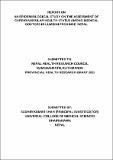Please use this identifier to cite or link to this item:
https://hdl.handle.net/20.500.14356/2722Full metadata record
| DC Field | Value | Language |
|---|---|---|
| dc.contributor.author | Shah, Sudhir Kumar | - |
| dc.date.accessioned | 2025-07-11T05:44:24Z | - |
| dc.date.available | 2025-07-11T05:44:24Z | - |
| dc.date.issued | 2022 | - |
| dc.identifier.uri | https://hdl.handle.net/20.500.14356/2722 | - |
| dc.description | Research Report | en_US |
| dc.description.abstract | Background: Cardiovascular disease (CVD) is the largest cause of mortality and morbidity globally, killing almost 17.9 million people every year, representing 32% of all global deaths. Diabetes mellitus, hypertension and obesity are very strongly associated with cardiovascular diseases all over the world. In order to reduce the burden of CVD, we first need to assess cardiovascular health status of population. Medical Doctors play a vital role in the health and welfare of the people of a nation. Health of the doctors is of paramount importance because they themselves must be healthy to perform their jobs optimally under challenging work environments. Additionally, evidence suggests that there is a strong and consistent relationship between physician’s health choices and the recommendations he or she makes to his or her patients. Methods: In a Cross-sectional study, Cardiovascular health status of 354 sampled doctor’s population of Lumbini Province were assessed using pre-designed and pre-tested semi structured questionnairefromAugust 2022 to March2023. Samples were taken from doctor’s population using non probability purposive sampling technique. Blood pressure, Blood glucose, Blood cholesterol, Body height and weight were measured using standard guidelines. Collected data were entered and analysed using Statistical Package for the Social Sciences (SPSS version 26). Descriptive statistic procedures were used for the calculation central tendency and dispersion measures. Chi- Square or Fisher exact test were applied to find out association. P value of less than 0.05 were considered as statistically significant. Results: Mean age of study population was 37.89(±7.70) years. Hypertension was seen among 22% of doctor’s population. Among doctors, 58% had ideal level of fasting blood sugar and 77% had ideal level of cholesterol level. The present study showed substantially high prevalence of obesity BMI > 23(65%) among doctors population. Married were more obese (65%), hypertensive (26%) and diabetics (14%) compared to unmarried. Conclusions: The prevalence of critical risk factors for cardiovascular disease that includes Hypertension, Diabetes mellitus, Hypercholesterolemia and obesity is high among doctors and hence it is a cause for concern. Healthy lifestyle measures might reduce burden of CVD which could be evaluated in future research. Keywords: Cardiovascular disease; Diabetes Mellitus; Hypertension; Obesity; Hypercholesterolemia. | en_US |
| dc.language.iso | en_US | en_US |
| dc.publisher | Universal College of Medical Science and Teaching Hospital | en_US |
| dc.subject | Cardiovascular disease | en_US |
| dc.subject | Diabetes Mellitus | en_US |
| dc.subject | Hypertension | en_US |
| dc.subject | Obesity | en_US |
| dc.subject | Hypercholesterolemia | en_US |
| dc.title | An epidemiological study on the assessment of cardiovascular health status among medical doctors in Lumbini province, Nepal | en_US |
| dc.type | Research report | en_US |
| Appears in Collections: | Provincial Grant Reports | |
Files in This Item:
| File | Description | Size | Format | |
|---|---|---|---|---|
| RES001211-SHA-2022.pdf | Download. | 1.7 MB | Adobe PDF |  View/Open |
Items in DSpace are protected by copyright, with all rights reserved, unless otherwise indicated.
